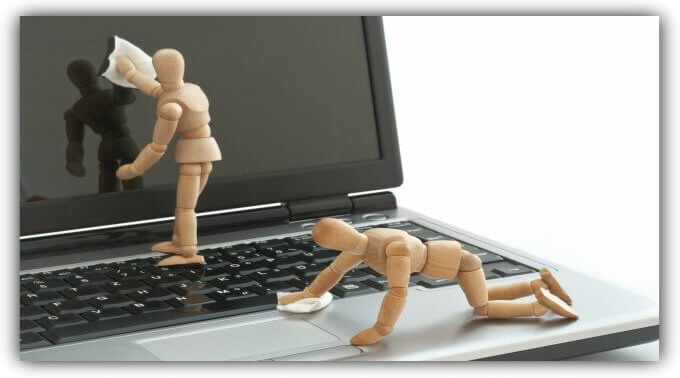
Your HP laptop running Windows 10 may be slow due to a combination of factors such as insufficient RAM, excessive background processes, and malware.
The operating system’s memory requirements have increased with newer updates, leading to decreased performance on older devices.
Additionally, unnecessary startup programs and services can consume system resources, slowing down your laptop further. Finally, malware or unnecessary files can also impact performance.
For a faster experience, consider upgrading your RAM, disabling unnecessary startup programs, performing regular malware scans, and optimizing your system through disk cleanup and defragmentation.
Understanding The Causes Of Slow Performance

Understanding the causes of slow performance in your HP laptop running Windows 10 is crucial for finding effective solutions to improve its speed and overall performance.
There are several factors that can contribute to a slow-running laptop, and in this blog post, we will explore some of the common culprits.
1. Overloaded Startup Programs
One of the main reasons for a sluggish HP laptop is having too many startup programs.
When you turn on your laptop, these programs automatically launch and run in the background, consuming valuable system resources.
Over time, the number of startup programs can increase significantly, leading to slower boot times and decreased overall performance.
To check and manage your startup programs in Windows 10, follow these simple steps:
- Press the Ctrl+Shift+Esc keys simultaneously to open the Task Manager.
- Click on the Startup tab at the top of the window.
- You will see a list of all the programs that launch at startup. Disable any unnecessary programs by right-clicking on them and selecting Disable.
- Restart your laptop to see the effects of these changes.
Insufficient Ram Capacity
The Random Access Memory (RAM) is responsible for temporarily storing data that the processor needs to access quickly.
If your HP laptop does not have enough RAM capacity to handle the applications and processes you run, it can significantly slow down performance.
To determine if insufficient RAM is the cause of your laptop’s slow speed, follow these steps:
- Press the Windows+X keys and select System from the menu.
- Under the System section, you will see the installed memory (RAM). Check if it is below the recommended amount for your specific needs.
- If insufficient, consider upgrading your laptop’s RAM capacity. Consult your user manual or contact HP support for assistance with the upgrade process.
2. Hard Drive Fragmentation
Another common reason for slow performance on an HP laptop is hard drive fragmentation.
As you use your laptop, files, and data stored on the hard drive can become fragmented, meaning they are scattered and not stored in a contiguous manner.
This fragmentation can lead to slower read and write speeds, resulting in overall sluggishness.
To defragment your hard drive on Windows 10:
- Press the Windows+X keys and select File Explorer from the menu.
- In the File Explorer, right-click on the hard drive you want to defragment (usually the C: drive) and select Properties.
- In the Properties window, click on the Tools tab and then click on Optimize under the Optimize and defragment drive section.
- Select the drive and click on the Analyze button to see if it requires optimization. If it does, click on the Optimize button.
- Wait for the optimization process to complete, and then restart your laptop to see the performance improvements.
3. Outdated Device Drivers
Outdated device drivers can also be a significant cause of slow performance on your HP laptop.
Device drivers allow your operating system to communicate with various hardware components of your laptop, and outdated drivers can lead to compatibility issues and decreased performance.
To update your device drivers in Windows 10:
- Press the Windows+X keys and select Device Manager from the menu.
- In the Device Manager window, expand the categories and locate the devices with outdated drivers (they are usually marked with a yellow exclamation mark).
- Right-click on the device and select Update driver.
- Choose the appropriate method to update the driver. You can opt to automatically search for driver updates online or manually select a driver you have already downloaded.
- Follow the on-screen instructions to complete the driver update process.
By understanding the causes of slow performance on your HP laptop running Windows 10, you can take the necessary steps to improve its speed and overall efficiency.
Managing startup programs, upgrading RAM, defragmenting the hard drive, and updating device drivers are essential actions that can significantly enhance your laptop’s performance.
Troubleshooting Slow Performance Issues

Is your HP laptop running slower than usual on Windows 10? This can be incredibly frustrating and hinder your productivity.
However, there are several troubleshooting steps you can take to improve the performance of your laptop.
In this article, we will walk you through some effective methods to address the slow performance issues on your HP laptop.
1. Clearing Temp Files And Cache
Over time, temporary files and cached data can accumulate on your laptop, taking up valuable storage space and slowing down your system.
Clearing these files can help improve the overall performance of your HP laptop.
Follow the steps below to clear temporary files and cache:
- Click on the Start menu and type “Disk Cleanup” in the search box.
- Click on the Disk Cleanup app from the search results.
- Select the drive where Windows is installed (usually the C: drive).
- Check the boxes for “Temporary files” and “Temporary Internet Files”.
- Click on the “OK” button to start the cleanup process.
2. Disabling Unnecessary Startup Programs
When you start your HP laptop, certain programs automatically launch in the background, which can slow down the startup process.
Disabling unnecessary startup programs can significantly improve the boot time and overall performance of your laptop.
Here’s how you can disable startup programs:
- Press Ctrl + Shift + Esc to open the Task Manager.
- Click on the “Startup” tab.
- Right-click on the programs you want to disable and select “Disable”.
- Restart your laptop for the changes to take effect.
3. Adding More Ram
If your HP laptop is still running slow after trying the previous methods, it might be due to insufficient RAM
Upgrading your RAM can significantly improve the performance of your laptop, allowing it to handle more tasks simultaneously.
Consider adding more RAM to your laptop based on its compatibility and your specific needs.
4. Defragmenting The Hard Drive
Over time, files on your hard drive can become fragmented, leading to slower performance.
Defragmenting the hard drive can rearrange the fragmented files, optimizing the file access and improving the overall speed of your HP laptop. Follow the steps below to defragment your hard drive:
- Click on the Start menu and type “Defragment and Optimize Drives” in the search box.
- Click on the “Defragment and Optimize Drives” app from the search results.
- Select the drive you want to defragment (usually the C: drive).
- Click on the “Optimize” button to start the defragmentation process.
5. Updating Device Drivers
Outdated device drivers can also contribute to slow performance on your HP laptop.
Updating your device drivers to the latest versions can fix compatibility issues and improve the overall functionality of your laptop.
Here’s how you can update your device drivers:
- Right-click on the Start menu and select “Device Manager”.
- Expand the categories and locate the device drivers you want to update.
- Right-click on the device driver and select “Update driver”.
- Choose the option to automatically search for updated driver software.
- Follow the on-screen instructions to complete the driver update process.
By following these troubleshooting steps, you can successfully address the slow performance issues on your HP laptop running Windows 10.
Clearing temp files and cache, disabling unnecessary startup programs, adding more RAM, defragmenting the hard drive, and updating device drivers can significantly improve the speed and overall performance of your laptop.
Optimize Windows Settings For Better Performance
Is your HP laptop running slow on Windows 10? Don’t worry, you’re not alone. Many users face the frustration of an underperforming laptop, but fortunately, there are some simple steps you can take to optimize your Windows settings for better performance.
In this article, we will explore three key areas where you can make adjustments to improve the speed and responsiveness of your HP laptop running Windows 10.
1. Adjust Visual Effects
One of the first things you can do to optimize your HP laptop’s performance is to adjust the visual effects settings in Windows 10.
By default, Windows 10 comes with a range of graphical enhancements and animations that can consume valuable system resources.
To disable these unnecessary visual effects and improve overall performance:
- Right-click on the Start button and select “System” from the context menu.
- In the System window, click on the “Advanced system settings” link on the left-hand side.
- In the System Properties dialog box, click on the “Settings” button under the Performance section.
- In the Performance Options window, you can choose between “Adjust for best performance” or “Custom”. If you select “Adjust for best performance,” Windows 10 will automatically disable all visual effects. Alternatively, you can choose the “Custom” option to manually select which visual effects to enable or disable.
- Click “Apply” and then “OK” to save the changes.
2. Disable Unnecessary Services
An additional way to optimize your HP laptop’s performance is to disable unnecessary services running in the background.
Many services run automatically on Windows 10, consuming system resources even when you’re not using them. To disable unnecessary services:
- Press the Windows key + R on your keyboard to open the Run dialog box.
- Type “services.msc” and press Enter to open the Services window.
- In the Services window, you will see a list of services. Identify the ones that you don’t need and could be safely disabled.
- Right-click on the service name and select “Properties”.
- In the Properties window, click on the “Stop” button to stop the service. Then, change the “Startup type” to “Disabled” to prevent it from running automatically in the future.
- Click “Apply” and then “OK” to save the changes.
3. Manage Startup Programs
Another factor that contributes to your HP laptop’s sluggishness is the number of programs that automatically launch during startup.
These programs can significantly slow down the booting process and hog system resources. To manage the startup programs:
- Open the Task Manager by pressing the Ctrl + Shift + Esc keys simultaneously.
- In the Task Manager window, click on the “Startup” tab.
- You will see a list of programs that launch during startup. Disable the ones that are not necessary by right-clicking on them and selecting “Disable”.
- Only keep the essential programs enabled, such as antivirus software or drivers.
By adjusting visual effects, disabling unnecessary services, and managing startup programs, you can significantly improve the performance of your HP laptop running Windows 10.
Take these simple steps and experience a faster, more responsive computing experience.
Additional Tips For Improving Laptop Speed
Is your Hp laptop running slow on Windows 10? Don’t worry, there are several steps you can take to boost its performance. In addition to addressing common issues like regular disk cleanup and system maintenance, there are also advanced techniques such as keeping software updated, running antivirus scans, and upgrading to a solid-state drive (SSD). Let’s explore these methods in detail:
Regular Disk Cleanup
A cluttered hard drive can significantly slow down your laptop’s overall performance. Therefore, it is essential to perform regular disk cleanup. This process involves removing unnecessary files, temporary data, and redundant downloads that accumulate over time. By clearing up this clutter, you can free up valuable space on your disk, leading to improved system speed. To perform disk cleanup:
- Click on the Start button and search for “Disk Cleanup”.
- Select the drive you want to clean up (usually C:).
- Tick the checkboxes next to the file types you wish to remove, such as temporary files and recycle bin contents.
- Click “OK” to initiate the cleanup process.
Performing disk cleanup regularly can help eliminate unnecessary files and optimize your laptop’s speed.
Performing System Maintenance
System maintenance involves several proactive steps to ensure your laptop is operating at its best. It includes tasks like defragmenting the hard drive, updating drivers, and managing startup programs. To perform system maintenance:
- Defragment the hard drive: Open the Start menu, search for “Defragment and Optimize Drives”, select the drive, and click “Optimize”.
- Update drivers: Open the Device Manager, locate the device driver, right-click on it, and select “Update driver”.
- Manage startup programs: Press Ctrl + Shift + Esc to open the Task Manager, click on the “Startup” tab, and disable unnecessary programs from launching at startup.
Performing regular system maintenance can enhance your laptop’s speed and overall performance.
Keeping Software Updated
Outdated software not only poses security risks but can also impair your laptop’s speed. It is crucial to keep your operating system, drivers, and software applications up to date. Manufacturers frequently release updates that address vulnerabilities and improve performance. To keep your software updated:
- Enable automatic updates: Go to “Settings > Update & Security > Windows Update” and turn on “Automatically download updates”.
- Keep applications updated: Install updates for various applications regularly or enable their auto-update feature if available.
By keeping your software updated, you can ensure your laptop functions optimally.
Running Antivirus Scan
Viruses and malware can significantly impact your laptop’s speed and compromise your data. Running regular antivirus scans can help detect and remove such malicious threats, improving your laptop’s performance. To run an antivirus scan:
- Open your installed antivirus software.
- Initiate a full system scan to check for any infected files or potential threats.
- Follow the on-screen instructions to quarantine or remove the detected threats.
A regular antivirus scan can safeguard your laptop and ensure it runs smoothly.
Upgrading To Solid State Drive (ssd)
One of the most effective ways to boost your laptop’s speed is by upgrading to a solid-state drive (SSD). Unlike traditional hard drives, SSDs offer faster read and write speeds, significantly improving the overall performance of your laptop. However, it is recommended to seek professional assistance for the upgrade process to avoid any data loss or damage. Upgrading to an SSD can provide a substantial performance boost to your Hp laptop.
By implementing these additional tips, you can significantly enhance the speed and performance of your Hp laptop running Windows 10. Whether it’s regular disk cleanup, system maintenance, keeping software updated, running antivirus scans, or upgrading to an SSD, these methods can help optimize your laptop and ensure a smooth computing experience.
FAQs For Why Is My HP Laptop So Slow Windows 10
How Do I Fix My HP Laptop From Running Slow Windows 10?
To fix a slow HP laptop running Windows 10, you can try these steps:
1. Clean up unnecessary files and programs.
2. Update your laptop’s drivers.
3. Disable startup programs.
4. Adjust your laptop’s visual effects.
5. Upgrade your laptop’s RAM or hard drive.
How Can I Speed Up My HP Laptop Windows 10 Pro?
To speed up your HP laptop with Windows 10 Pro, you can try these tips:
1. Clean up your hard drive by removing unnecessary files and programs.
2. Disable startup programs to improve boot speed.
3. Update your device drivers regularly for optimum performance.
4. Increase your laptop’s RAM if possible.
5. Use a reliable antivirus program to scan for malware and viruses.
How Do I Clean Up My HP Computer To Make It Run Faster?
Clean up your HP computer for improved speed by removing unnecessary files, uninstalling unused programs, running a malware scan, disabling startup programs, and optimizing your hard drive.
Why Does My HP Laptop Take So Long To Load?
Your HP laptop may take longer to load due to several reasons, such as low RAM, fragmented hard drives, too many startup programs, or outdated software. Increasing RAM, defragmenting the hard drive, disabling unnecessary startup programs, and updating software can help improve loading speed.
Why Is My HP laptop Running Slow On Windows 10?
There could be several reasons for your HP laptop running slow on Windows 10, such as outdated drivers, excessive background programs, inadequate RAM, or a full hard drive.
How Can I Speed Up My HP Laptop On Windows 10?
To speed up your HP laptop on Windows 10, you can try deleting unnecessary files, disabling startup programs, updating your drivers, increasing RAM, and performing regular maintenance tasks like disk cleanup and defragmentation.
Does Installing More RAM Make My HP Laptop Faster?
Yes, installing more RAM can improve your HP laptop’s speed as it allows the system to handle multiple tasks simultaneously and reduces the reliance on virtual memory.
What Is The Recommended Amount Of RAM for An HP laptop On Windows 10?
For optimal performance on Windows 10, it is recommended to have at least 8GB of RAM on your HP laptop. However, if you frequently use resource-intensive applications, you may consider upgrading to 16GB.
Can A Full Hard Drive Make My HP Laptop Slow?
Yes, a full hard drive can significantly slow down your HP laptop as it restricts the space available for the operating system to function properly. Ensure you have enough free disk space for efficient performance.
How Often Should I Update My HP Laptop’s Drivers?
It is advisable to regularly update your HP laptop’s drivers to ensure compatibility with the latest software and hardware updates. Check for driver updates on a monthly basis or whenever you experience performance issues.
Conclusion of Why Is My HP Laptop So Slow Windows 10
A slow HP laptop running on Windows 10 can be frustrating and hinder productivity.
By following the troubleshooting steps outlined in this blog post, such as optimizing startup programs, updating drivers, and clearing unwanted files, you can significantly improve your laptop’s performance.
Remember to regularly perform maintenance tasks to keep your system running smoothly.
With these simple yet effective solutions, you’ll be able to enjoy a faster and more efficient computing experience.
Read also: Why is My Laptop Slow All of a Sudden

![How to Speed Up a Windows Laptop? [12 Easy Steps] 7 How to Speed Up a Windows Laptop](https://bestlaptopsventure.com/wp-content/uploads/2024/02/How-to-Speed-Up-a-Windows-Laptop-1024x576-1.jpg)

![9 Best i5 Laptops - 13th Gen Intel Core i5 Laptops in July 2025 [Expert Recommended] 9 Best i5 Laptops](https://bestlaptopsventure.com/wp-content/uploads/2024/03/best-i5-laptops-1024x536-1.jpg)
![9 Best DELL Laptops with Backlit Keyboard in July 2025 [Expert Recommended] 10 Best DELL Laptops with Backlit Keyboard](https://bestlaptopsventure.com/wp-content/uploads/2024/03/Best-dell-laptops-with-backlit-keyboard-1024x536-1.jpg)
![9 Best Laptops For Cricut Explore Air, Air 2 in July 2025 [Expert Recommended] 11 Best Laptops for Cricut Explore Air, Air 2](https://bestlaptopsventure.com/wp-content/uploads/2024/02/best-laptops-for-cricut-explore-air-air-2-maker-1.jpg)


![9 Best Laptop For Stay At Home Mom in July 2025 [Expert Recommended] 14 Best Laptop For Stay At Home Mom](https://bestlaptopsventure.com/wp-content/uploads/2024/04/best-laptop-for-stay-at-home-mom.jpg)

![9 Best Laptops for Psychology Graduate Students in July 2025 [Expert Recommended] 16 Best Laptop for Psychology Graduate Students](https://bestlaptopsventure.com/wp-content/uploads/2024/02/best-laptop-for-psychology-graduate-students-1.jpg)